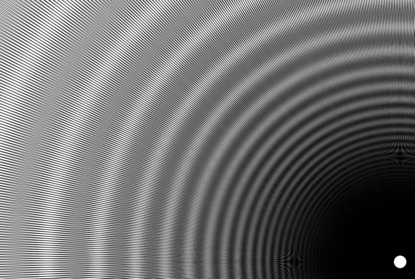Chiliagon
| Regular chiliagon | |
|---|---|
| Dual polygon | Self |

In
Regular chiliagon
A regular chiliagon is represented by Schläfli symbol {1,000} and can be constructed as a truncated 500-gon, t{500}, or a twice-truncated 250-gon, tt{250}, or a thrice-truncated 125-gon, ttt{125}.
The measure of each
This result differs from the area of its
Because 1,000 = 23 × 53, the number of sides is neither a product of distinct
Philosophical application
René Descartes uses the chiliagon as an example in his Sixth Meditation to demonstrate the difference between pure intellection and imagination. He says that, when one thinks of a chiliagon, he "does not imagine the thousand sides or see them as if they were present" before him – as he does when one imagines a triangle, for example. The imagination constructs a "confused representation," which is no different from that which it constructs of a myriagon (a polygon with ten thousand sides). However, he does clearly understand what a chiliagon is, just as he understands what a triangle is, and he is able to distinguish it from a myriagon. Therefore, the intellect is not dependent on imagination, Descartes claims, as it is able to entertain clear and distinct ideas when imagination is unable to.[1] Philosopher Pierre Gassendi, a contemporary of Descartes, was critical of this interpretation, believing that while Descartes could imagine a chiliagon, he could not understand it: one could "perceive that the word 'chiliagon' signifies a figure with a thousand angles [but] that is just the meaning of the term, and it does not follow that you understand the thousand angles of the figure any better than you imagine them."[2]
The example of a chiliagon is also referenced by other philosophers.
Henri Poincaré uses the chiliagon as evidence that "intuition is not necessarily founded on the evidence of the senses" because "we can not represent to ourselves a chiliagon, and yet we reason by intuition on polygons in general, which include the chiliagon as a particular case."[6]
Inspired by Descartes's chiliagon example, Roderick Chisholm and other 20th-century philosophers have used similar examples to make similar points. Chisholm's "speckled hen", which need not have a determinate number of speckles to be successfully imagined, is perhaps the most famous of these.[7]
Symmetry

The regular chiliagon has Dih1000
John Conway labels these lower symmetries with a letter and order of the symmetry follows the letter.[8] He gives d (diagonal) with mirror lines through vertices, p with mirror lines through edges (perpendicular), i with mirror lines through both vertices and edges, and g for rotational symmetry. a1 labels no symmetry.
These lower symmetries allow degrees of freedom in defining irregular chiliagons. Only the g1000 subgroup has no degrees of freedom but can be seen as
Chiliagram
A chiliagram is a 1,000-sided
For example, the regular {1000/499} star polygon is constructed by 1000 nearly radial edges. Each star vertex has an

|
 Central area with moiré patterns |
See also
Notes
References
- ^ Meditation VI by Descartes (English translation).
- .
- ^ David Hume, The Philosophical Works of David Hume, Volume 1, Black and Tait, 1826, p. 101.
- ISBN 0198250924, p. 53.
- ^ Immanuel Kant, "On a Discovery," trans. Henry Allison, in Theoretical Philosophy After 1791, ed. Henry Allison and Peter Heath, Cambridge UP, 2002 [Akademie 8:121].
- ISBN 0198505361, p. 1015.
- ^ Roderick Chisholm, "The Problem of the Speckled Hen", Mind 51 (1942): pp. 368–373. "These problems are all descendants of Descartes's 'chiliagon' argument in the sixth of his Meditations" (Joseph Heath, Following the Rules: Practical Reasoning and Deontic Constraint, Oxford: OUP, 2008, p. 305, note 15).
- ^ The Symmetries of Things, Chapter 20


